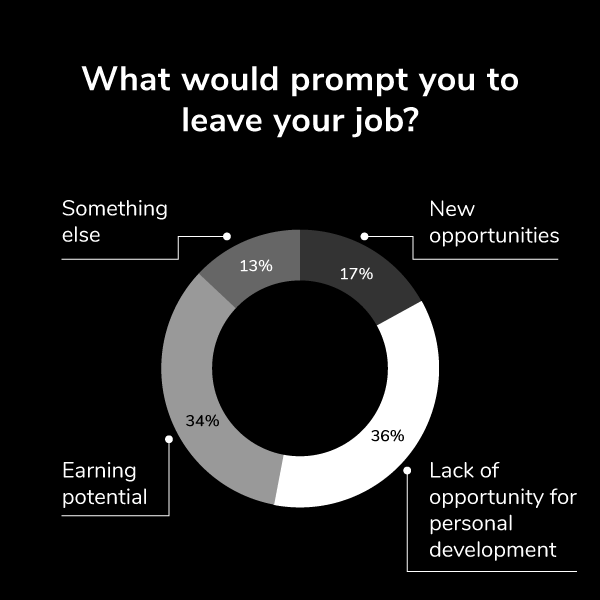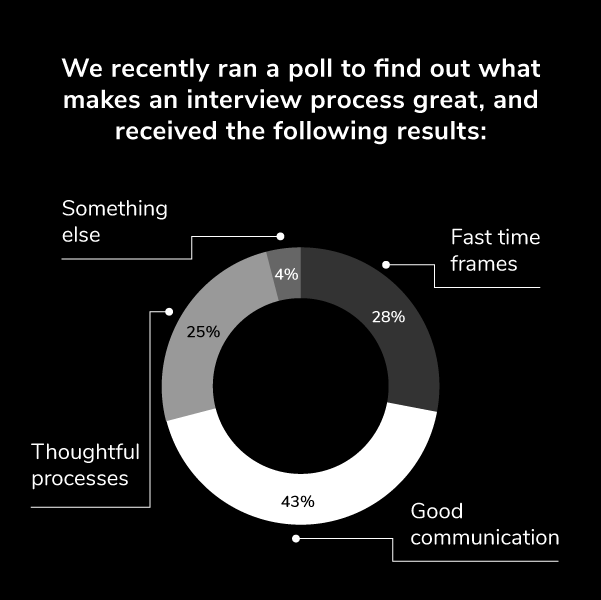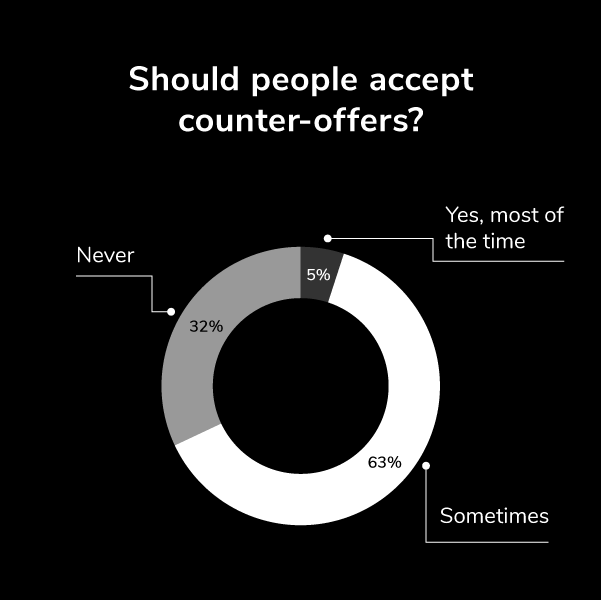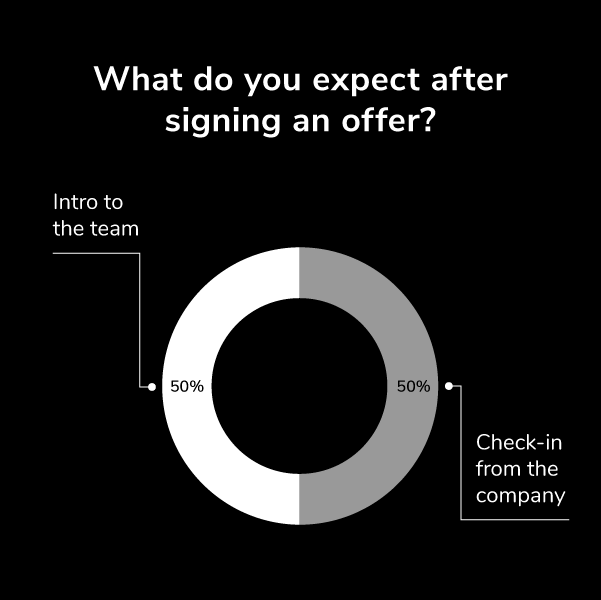You don’t need to look far to find damning figures on resignation rates. In fact, as many as a third of UK workers are considering a career change this year alone.
What are the factors that lead to resignations? How do these translate in the candidate market? What can companies do to successfully attract and retain top talent?
This blog aims to discuss these points in detail. If you have any further questions, don’t hesitate to get in touch.
Why people resign
Besides the normal flow of employees in companies – recruits joining and experienced people moving into new roles – companies are seeing a marked increase in people leaving. That’s due to a few key factors.

The job market: Simply put, there are more opportunities out there. For 17% of respondents in a recent poll we conducted, this was the key reason they’d resign. Depending on the person’s skill level and experience, they really could take their pick of jobs. That’s naturally going to lead to people reevaluating their position and exploring alternatives.
A work shift: Companies that are refusing to adapt to new ways of working are feeling the brunt of resignations, with employees demanding more flexibility and autonomy.
Opportunity for growth: 36% of respondents cited a lack of personal development as a reason for resigning, proving how important it is to keep up with what employees need from their jobs.
New priorities: After more than two years of dealing with the challenges of the pandemic, many people have taken the time to reassess what matters to them. While professional development may have been front of mind in 2020, people are now looking for career options that offer them a better work-life balance.
Salaries: There’s no getting around the importance of earning potential in retaining employees. It’s the main thing that attracts people to new roles and it plays a big part in why people decide to leave. While increases and bonuses might not be within every company’s reach, committing to appropriately rewarding those who work for you is key. Consider co-pays, flexible working options, rewards, vouchers, or time off to thank your employees.
There are many pervasive issues across the sector, and companies looking to attract the top talent would be wise to take note and adapt their working environment accordingly.
How to attract candidates
Once employers fully understand the challenges faced by people working in their sector, they can begin to put a plan in place that will make their company an attractive alternative.
A fantastic place to start is with one’s own team. Do you know what attracted your top performers to join your business in the first place? It’s a good idea to speak to them and establish the things you’re already doing right.
From there, move on to identifying the gaps in your employer brand. A good reputation amongst candidates is key in securing interviews and finding your next top hire.
We’ve seen cases where a candidate who was interested in a role backed out of the process once they learned who the employer was due to bad experiences in the past. This is despite new hiring managers joining and processes being tidied up.
Avoid being blacklisted by talent by considering these points:
- Consistent language and communication: From the first interaction with your company, a prospective candidate should understand your mission, product, and culture. Are you expressing your company’s place in the market and framing it as an exciting opportunity, or is the job coming across as just another 9-5?
- Social awareness: Show that you understand your team and the work they do by offering benefits and incentives that speak to their needs. Where possible, this also extends to flexibility in where and how you work.
- Clear room to grow: Before bringing anyone new onto the team, you need to understand how they’ll be able to grow and develop within your company. Once you’ve established that, speak to the candidate to find out how they’d like to develop and create a clear roadmap that makes that possible.
What pushes candidates away?
Even the best employer branding won’t save you if your interview process isn’t up to scratch. In most cases, it comes down to decent communication, clear expectations, and mutual respect. You can find more specific insights into this topic here.
We recently ran a poll to find out what makes an interview process great, and received the following results:

Off the back of these responses, here are the things to avoid when interviewing potential candidates.
Slow or inconsistent replies: A prospective candidate isn’t waiting around for your reply. Delaying your response, or falling flat on replying, can mean the difference between a candidate being interested or not.
Unprofessional processes: First impressions count, especially when you’re trying to impress an in-demand candidate. Ensure meetings are set up in advance, have the right people on the calls, and do your research before speaking to the person.
Someone in our community recently reached out to tell us about the frustration they’ve experienced with bad interviews:
“I recently interviewed for a buy-side equity role and was asked something along the lines of ‘What are your thoughts on markets in 2022?’. I think I would be surprised if a technology firm asked candidates ‘What are your thoughts on technology in 2022?’ I understand the motivation of questions like these, to get candidates to demonstrate an interest in financial markets. But I would be wary of how helpful such a vague question is in achieving this goal. “
Keep it efficient: Candidates want to know where they stand and whether or not they can expect an offer. They don’t want their time wasted with multiple rounds of tasks, meetings and regroups. Once you’re sure of your decision, take decisive action.
There’s another reason for moving things along and not wasting time while interviewing.

For the majority of respondents, it’s a morally grey area. While it’s objectively wrong to string along a company for the sole purpose of getting your current employer to pay you more, it could also be the only way some employees can get their message across.
By keeping the process from interview to making an offer short, you’re able to avoid wasting time on a candidate that may well end up going back to their current role.
What happens after the offer?
There are important details to pay attention to once you’ve found your ideal candidate. Getting that offer signed and starting the onboarding process is your next challenge.
40% of people would ghost an employer or recruiter if the initial job offer is too low. That goes to show how important it is to have open discussions in the interview phase, to set realistic expectations, and to know your market.
While you’re under pressure to get the offer out, keep in mind that the candidate is also anxious to hear back from you. Making an offer soon after concluding the interviews is a good way to illustrate your genuine interest and show the candidate that your intentions are sound.

Once they’ve accepted the offer, the biggest job is to keep the candidate warm. Notice periods can vary from a couple of days to several months, so it’s important to have check-ins before they start in their new position. Below are some ideas to consider.
- Introduce them to key members of the team they’ll be working with
- Provide them with important documentation
- Send them any necessary equipment (like laptops) sooner rather than later
- Get them set up on all platforms they’ll need to use
- Iron out any questions they may have about processes
- Clarify any benefits and perks
Successfully attracting candidates starts with knowing what they need and how you can offer it. Berkeley Croft is an experienced partner to companies in the investment management sector, providing industry-leading guidance and support to businesses looking to scale.
Get in touch to see how we can assist you.

